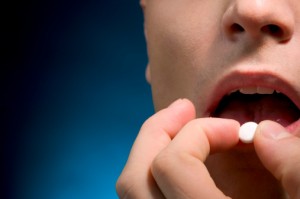Blood Fats: Taming Your Triglycerides
 Your health care provider has probably talked to you about your cholesterol level, and if it’s high, there are many ways to help bring it down. Has he or she also talked with you about your triglyceride level? If so, you might be wondering exactly what this is.
Your health care provider has probably talked to you about your cholesterol level, and if it’s high, there are many ways to help bring it down. Has he or she also talked with you about your triglyceride level? If so, you might be wondering exactly what this is.
The term “triglyceride” describes a specific type of fat, or lipid, found in the blood. Triglycerides are the form in which fat is found in the food that you eat and in your body. Triglycerides are the way fat is carried in your body, to be either used for fuel or stored as fat. Any calories from the food you eat that aren’t used for fuel right away are packaged as triglycerides and stored in your fat cells. Your liver also makes triglycerides. Your triglyceride level is measured by a blood test and is usually measured along with your total cholesterol, HDL and LDL cholesterol (called a lipid profile). You should not eat anything 12 hours before having your triglycerides measured.
What Causes High Triglycerides?
Several factors can cause high triglycerides. These include:
- Age: the older you are, the higher your triglycerides will be
- Being overweight or obese
- Not being physically active
- Smoking
- Drinking too much alcohol
- Eating a very high carbohydrate diet
- Certain conditions, such as diabetes, kidney disease, high blood pressure, liver disease and low thyroid
- Some medications, including diuretics (water pills), steroids and birth control pills
- Family history
 10 Ways to Tame Triglycerides
10 Ways to Tame Triglycerides
- Lose weight if you need to. Losing even a few pounds can help lower your triglycerides, as well as your blood glucose levels if you have diabetes.
- Manage your blood glucose levels. If you have diabetes and your blood glucose levels have been high, work with your healthcare team to help bring them down.
- Get regular physical activity. Being physically active on most days of the week not only helps lower triglycerides, it helps you manage your blood glucose, lowers your risk for heart disease, helps with weight control and can even relieve stress. Physical activity does not have to be strenuous. Talk to your health care provider about what kind and how much activity would be best for you, but keep in mind that even taking a walk every day can help.
- Stop smoking, if you do smoke. Studies show that smoking can raise triglyceride levels.
- Eat less saturated and trans fats. Both saturated fat, found in butter, shortening, red meat and whole milk, and trans fat, found in margarine, fast foods and certain snack foods, can raise your cholesterol and triglyceride levels, and put you at risk for heart disease. Instead, use heart healthy fats, such as olive and canola oil, and trans fat free margarine. Also include fatty fish (salmon, mackerel, sardines, trout), avocados, nuts and seeds in your eating plan. However, watch your portion sizes since all fats are very high in calories.
- Eat less sugar and sweets. Sugar and sweets, such as cookies, candy and cake, can raise triglycerides in some people. Sugar substitutes, including saccharin (Sweet ‘N Low), aspartame (Equal), sucralose (Splenda) and stevia (Pure Via) are fine to use for most people.
- Drink less alcohol. If your triglycerides are very high, it’s a good idea to cut back on, or even stop drinking, alcohol, whether it’s beer, wine or mixed drinks.
- Cut back on carbohydrates. Eating too much carbohydrate can raise triglyceride levels in some people. You should not stop eating carbohydrates, but you may need to eat smaller portions of refined carbohydrate foods, such as white bread, white pasta and white rice.
- Fill up on fiber. Fiber is found in fruits, vegetables and whole grain foods, such as whole wheat bread, bran cereals, oatmeal and brown rice. Eating high fiber foods every day can help you lower your triglyceride levels.
- Eat more meatless meals. Tofu, tempeh and soy “burgers” and “hot dogs” are tasty, healthy ways to help you cut back on red meat. And soy has been shown to lower triglyceride levels, too. You can also get protein from legumes, such as black beans, chick peas and lentils.
Are Triglycerides Harmful?
If the amount of triglycerides in your blood is too high, you may be at risk for heart disease. Very high triglycerides may also cause pancreatitis, a serious inflammation of the pancreas. If you have diabetes and your triglycerides are high, you may also have high blood glucose levels. Insulin, a hormone that lowers blood glucose, also lowers triglycerides, so high blood glucose and high triglycerides are often seen together. In some cases, high triglycerides are linked to undiagnosed diabetes.
What’s A Good Triglyceride Level?
Both the American Diabetes Association and the National Cholesterol Education Program recommend a triglyceride level of 150 mg/dL or lower. How can you lower your triglyceride level?
The good news is that there are many steps you can take to lower your triglycerides if they’re too high. Triglycerides tend to drop fairly quickly, compared to cholesterol. Be sure you talk with your healthcare team about why your triglycerides are high and how you can get them down. In the meantime, see the facts to your left for some ways to get started.
What About Medicine?
 You may need to take medicine to help lower your triglycerides if lifestyle changes aren’t enough. There are several different kinds of drugs that can help. These include statins (which also lower cholesterol levels), nicotinic acid (a type of niacin), fibrates, and prescription strength omega-3 fatty acids. If you do need to take medicine, your provider will check your blood triglycerides regularly to see how the medicine is working.
You may need to take medicine to help lower your triglycerides if lifestyle changes aren’t enough. There are several different kinds of drugs that can help. These include statins (which also lower cholesterol levels), nicotinic acid (a type of niacin), fibrates, and prescription strength omega-3 fatty acids. If you do need to take medicine, your provider will check your blood triglycerides regularly to see how the medicine is working.
Fish Oil Supplements
The American Heart Association recommends eating fatty fish at least two times per week. The kind of fat found in fish, called omega-3 fatty acids, can help lower blood triglyceride levels.
Omega-3 fatty acids also come in capsule form for people who don’t like or can’t eat fish. Your healthcare provider may suggest you take omega-3 fatty acids in a supplement to lower your triglyceride levels. However, you should only take these under his or her care.


 10 Ways to Tame Triglycerides
10 Ways to Tame Triglycerides